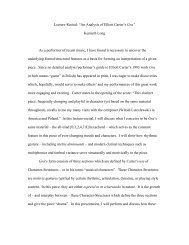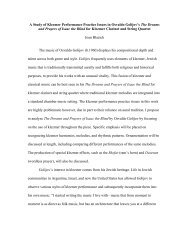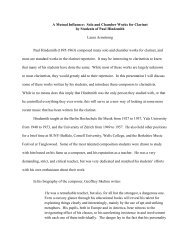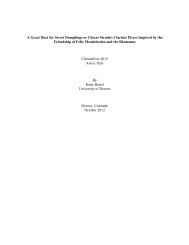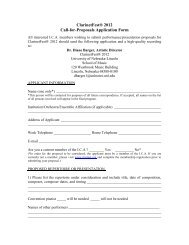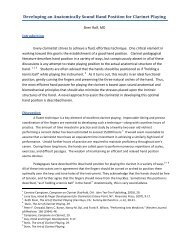Volume 33 Number 3 June 2006 - International Clarinet Association
Volume 33 Number 3 June 2006 - International Clarinet Association
Volume 33 Number 3 June 2006 - International Clarinet Association
- No tags were found...
You also want an ePaper? Increase the reach of your titles
YUMPU automatically turns print PDFs into web optimized ePapers that Google loves.
Baermann certainly rectified<br />
shortcomings in the<br />
“Carl<br />
older editions (or the original<br />
source texts), but in the process of his own<br />
editorial work he swung to the opposite<br />
extreme: in his editions every bar contains<br />
the minutest instructions regarding dynamics<br />
and articulation. […] in many places it<br />
is clear that in his attempt to add precision<br />
to the rudimentary markings in the sources<br />
he either misunderstood Weber’s intentions<br />
or made the conscious decision to<br />
contravene them.”<br />
This is one of the repeated pleadings for<br />
a more critical assessment of the famous<br />
Baermann editions of Weber’s clarinet<br />
works to be found in the new volume of<br />
the Carl-Maria-von-Weber-Gesamtausgabe<br />
(Complete Works by C. M. v. Weber). This<br />
volume comprises the composer’s chamber<br />
music for clarinet: The Silvana-variations<br />
in B ♭ major, Op. <strong>33</strong>, the <strong>Clarinet</strong><br />
Quintet in B ♭ major, Op. 34 and the Grand<br />
Duo Concertant in E ♭ major, Op. 48. 1 All<br />
of these works (like the concerti for clarinet<br />
and orchestra, which Frank Heidlber<br />
ger discussed in his essay in volume 30,<br />
no. 1 of this periodical) had been composed<br />
for — or together with — the famous Munich<br />
clarinetist Heinrich Joseph Baermann<br />
(1784–1847) between 1810 and 1815. And<br />
all works had been published in 1870 in a<br />
new edition of Baermann’s son Carl Baermann<br />
(1811–1885) in which the son pretended<br />
to present these works in the way<br />
his father played them (with Weber). 2<br />
The new edition is extremely sceptical<br />
about this statement: Carl Baermann’s editions<br />
were made more than 50 years after<br />
the works had been composed and more<br />
than 20 years after Heinrich Baermann’s<br />
death. Carl was at the tender age of four<br />
when Weber for the last time met his friend<br />
in Munich. (Later Heinrich Baermann visited<br />
Weber in Dresden without his son.)<br />
May we really suppose that a small boy of<br />
four years had such a precise power of<br />
recollection And if his father later played<br />
the works very differently from the text<br />
published (as Carl reported in a letter to<br />
the Weber researcher Friedrich Wilhelm<br />
Jähns in 1865), who is willing to guarantee<br />
that this had to do with the influence of<br />
the composer<br />
In fact, the editions of Carl Baermann<br />
are interpreting text-editions typical for the<br />
mid-19th century: all details of the dynamics<br />
and articulation are codified with a precision<br />
that shows the deep knowledge of<br />
Page 40<br />
Weber’s <strong>Clarinet</strong><br />
Chamber Music<br />
Without Baermann<br />
The New <strong>Volume</strong> of the<br />
Carl-Maria-von-Weber-Gesamtausgabe<br />
and the Digital Edition of the Quintet, Op. 34<br />
THE CLARINET<br />
by Joachim Veit<br />
the instrument Baermann’s son had. Compared<br />
with Weber’s manuscripts one may<br />
speak of an all-dressed-up edition in the<br />
case of Baermann and a nearly naked textpresentation<br />
in the case of Weber. This is<br />
especially true if one considers Weber’s<br />
autographs. In the autographs of the <strong>Clarinet</strong><br />
Quintet (Berlin, State Library) und the<br />
Grand Duo (Washington, Library of Congress)<br />
there are some pages which consist<br />
only of note symbols, nearly without dynamics<br />
and phrasing. In both cases these<br />
autographs were designed to serve as copies<br />
for Weber’s own archive, so it was not<br />
necessary to include all the hints which a<br />
performer needed — Weber knew in which<br />
way he had to fill in the blank spaces. But<br />
if we today would try to publish a new edition<br />
based on these autograph manuscripts<br />
we would burden the performer with so<br />
many inconveniences and uncertainties that<br />
such an edition would be really useless. It<br />
is not astonishing that the former edition of<br />
Günter Hausswald (published in 1953 by<br />
Breitkopf & Härtel), which was based on<br />
the autograph, was reprinted in 1989 with<br />
practical additions by Wolfgang Meyer.<br />
Pamela Weston, in her edition of the Grand<br />
Duo following the autograph (Corby: Fentone,<br />
1989), added a second version beneath<br />
Weber’s text in which she gave her<br />
own interpretation of the work. The amount<br />
of “blank space” in Weber’s autographs<br />
seduced the clarinetists to prefer the convenient<br />
Baermann edition — until today.<br />
The new Weber Complete Edition now<br />
for the first time exploits the engraver’s<br />
copy-texts of these two works which had<br />
been hitherto overlooked by other editors.<br />
Both manuscripts (housed again at Washington<br />
and Berlin as well as in the Vienna<br />
Municipal Library) were written by copyists<br />
and thoroughly proofread by Weber.<br />
The composer directed his attention not so<br />
much on possible defects in pitch or rhythm<br />
but rather on dynamics, articulation<br />
and phrasing, i.e., the so-called secondary<br />
parameters of music. The result are manuscripts<br />
littered with pencil markings by<br />
Weber’s hand (at least in the case of the<br />
Duo and the first three movements of the<br />
Quintet; the Finale of this work seems not<br />
to be checked with such care). These manuscripts<br />
are of the utmost importance for<br />
any edition which endeavors to present an<br />
authentic text of the works — much more<br />
than the likewise often ignored first editions<br />
which were published from these<br />
copies with Weber’s consent but with a lot<br />
of defects caused by the engravers. In July<br />
1817 Weber wrote to his Berlin publisher<br />
Adolph Martin Schlesinger concerning the<br />
print of the Quintet parts: “I am enclosing<br />
the corrections of the quintet, in which there<br />
were significant mistakes.” The printing revised<br />
by Weber was then published as a<br />
corrected original edition (plate number<br />
189), but nevertheless a lot of mistakes are<br />
still to be found in these parts too. Often<br />
the engravers misinterpreted slurs, accents<br />
or dynamic markings of the copy-text. Thus<br />
the copy-text is clearly more authentic than<br />
the printed sources based on it.<br />
Weber’s entries in the copy-text are of<br />
special interest for the editor and perhaps<br />
for the performer too. Even if the new editions<br />
are based on these copy-texts as the<br />
main sources it seemed to be useful to inform<br />
the reader about these “specially<br />
authorized” details in the musical text. The




